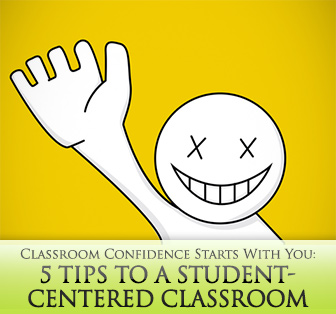
Creating a student-centered classroom will allow your students to blossom, work hard, and develop determined confidence.
Follow these 5 tips to build your own confidence in creating a student-centered environment.

How to Create a Student-Centered Classroom
-
1
Be a Politician, But Not Political
If you think about it, teachers are a lot like politicians. You have to please a lot of different people, stick to your promises, and meet and remember a lot of details about many different people. So one way to build a student-centered environment is to be like a politician without getting political. Teachers should never show favorites, give in simply because a demanding student is challenging you, or get entrenched in disagreements or bickering. Leave the politics to the politicians.
Be democratic whenever possible. Get their ideas and involve them in decision-making. Allow students choices when it comes to assignments, but don't leave it wide open unless it really serves the assignment. For example, if they have to write a paragraph using a particular grammar point, give them two to three options to choose from. However if they have to do a two-minute persuasive speech, allow them to brainstorm and formulate a topic that is meaningful to them.
Get to know their likes and dislikes and remember the details. In order to help them succeed you need to learn about them as individuals, and bring their interests into classroom discussion and activities. Also, discovering why they are studying and what motivates them will help you inspire them.
-
2
Sharing is Caring
It is essential to build community in your classrooms. Allow the students room to work in all types of different situations and with all different people. Vary group and pair work, and try out unlikely combinations or completely random ones. When you involve students on a personal level they begin to get to know one another and a sense of camaraderie will develop naturally. Give them a forum to share their experiences, family details, goals, and most of all, their personalities. Students should feel comfortable and encouraged to be themselves and to develop healthy classroom relationships. Be careful not to push students who are more private or who wish to remain more professional with their classmates. Respect boundaries, and if they don't want to share, don't force the issue.
-
3
Wear Different Hats
Students respect a teacher that protects them, and has their best interests at heart. If problems arise in the class, students need to know that they can count on you to be firm and resolve the issue. Find ways to diffuse difficult situations, use humor whenever possible as long it is appropriate, and set boundaries that students can easily understand and adhere to. If there are personality conflicts in the class, put on the hat of mediator. If there is an upset student, try your hand at counseling the student or the group. If there is a crisis of some kind, remain calm and take the best care of students that you can. Wear all the different hats necessary to foster a safe and secure environment.
-
4
Review, Review, Review
Language learners need constant reinforcement and varied review. A portion of each lesson should focus on reviewing the familiar and going over previously learned topics. This gives students a chance to show what they know which builds confidence, practice something that comes easily which reinforces what they learned, and work out any kinks in a safe environment. Review can be done in many different ways, and you can involve students by asking them to define principles, tell you something they know about a topic, or ask them for examples of a particular point. This is an extremely student-centered and student-friendly approach to bringing in the old and making it fresh again. Allow students to shine and display what they know so that they always remember that they are learning a lot.
-
5
Learning Contracts
In developing a student-centered environment, you will learn a great deal about students and their goals, desires, and setbacks. Some teachers really like students to assess their own goals for the class and how they believe it will impact their lives. One way to document this is to have students do learning contracts or goal sheets. A learning contract is simply a formal way for students to record things like:
- What they want to accomplish
- In what timeframe they would like to accomplish it
- How they plan to reach their goal, with concrete examples
- What help or support will they need to reach their goal
If you decide to have students do one of these contracts, it is important that you revisit the contracts at specified times and create open dialogues about accomplishments. You can also take on the role of calling them out when they might be slacking a bit, praising them when they are making great strides, or troubleshooting with them in order to gain more headway. This type of contract may really appeal to some students who take it very seriously. Others may not like it, and may only go through the motions. It is up to you to determine if this type of agreement is a good fit for the whole group or if you would rather just do some personal goal-setting exercises with students.
There's no end to the ways in which you can create a student-centered classroom every day of the week.
Follow the above 5 tips and you will find that centering on students builds confidence in everyone, and provides innumerable benefits.
P.S. If you enjoyed this article, please help spread it by clicking one of those sharing buttons below. And if you are interested in more, you should follow our Facebook page where we share more about creative, non-boring ways to teach English.







